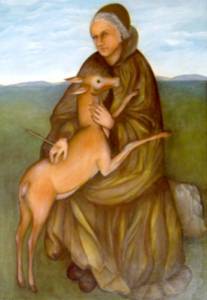
Feastday: April 23
Birth: 1190
Death: 1262
Beatified: 1777 by Pope Pius VI
A native of Assisi, Italy, Giles was one of the earliest followers of St. Francis, from whom he received the habit in 1208. He accompanied Francis on many of his missions around Assisi, made a pilgrimage to Compostela, visited Rome and the Holy Land, and then made an unsuccessful visit to Tunis to convert the Saracens. The Christians in Tunis, fearful of the repercussions of his religious fervor, forced him back on a boat as soon as he landed. He spent the rest of his life living in Italy, living from about 1243 at the Monte Rapido hermitage on the outskirts of Perugia, where he died in 1263. He experiences ecstacies, had a vision of Christ at Cetona, and is considered the most perfect example of the primitive Franciscan. He is spoken of at length in "The Little Flowers of St. Francis" and Francis called him his "Knight of the round table." Known for his austerity and silence, his "The Golden Sayings of Brother Giles" is noted for its humor, deep understanding of human nature, and optimism.
Giles of Assisi (Latin: Aegidius; c. 1190 – 1262), was one of the original companions of Francis of Assisi and holds a leading place among them. St. Francis called him "The Knight of our Round Table".
Life
Of Giles' origins and early life nothing certain is known, other than that he was a simple farmer. In April, 1209, moved by the example of two leading fellow-Assisians, who had already become the first followers of St. Francis, he begged permission to join the little band, and on the feast of St. George (23 April) was invested in a poor religious habit which St. Francis had begged for him. Almost immediately afterwards he set out with St. Francis to preach in the Marches of Ancona. He accompanied Francis of Assisi to Rome when the first Rule was approved orally by Pope Innocent III, and appears to have then received the monastic tonsure.
About 1212 Giles made a pilgrimage to the tomb of St. James at Compostella, in Spain. Shortly after his return to Assisi he started for Jerusalem, to venerate the Holy Places, visiting on his way home the Italian shrines of St. Michael, at Monte Gargano, and St. Nicholas, at Bari. He is next found in Rome and still later at Tunis.
In these journeys Giles was always at pains to procure by manual labor what food and shelter he needed. At Ancona he made reed baskets; at Brindisi he carried water and helped to bury the dead; at Rome he cut wood, trod the wine-press, and gathered nuts; while the guest of a cardinal at Rieti he insisted on sweeping the house and cleaning the knives. A keen observer of men and events, Giles acquired in the course of these travels much valuable knowledge and experience, which he turned to good account. For he lost no occasion to preach to the people. His sermons, if such they can be called, were brief and heartfelt talks, replete with homely wisdom; he never minced his words, but spoke to all with apostolic freedom. After some years of activity Giles was assigned by St. Francis to the hermitage of Monteripido, outside Perugia, where he began a life of contemplation and ecstasy which continued with very visible increase until his death.
It was in 1262, on the fifty-second anniversary of his reception into the Order of Friars Minor, that Giles died, already revered as a saint. His immemorial cultus was confirmed by Pope Pius VI in 1777, and his feast day is celebrated on the 23 April.
Giles was a stranger to theological and classical learning, but by constant contemplation of heavenly things, and by the divine love with which he was inflamed, he acquired that fullness of holy wisdom which filled his contemporaries with wonder, and which drew men of every condition, even the Pope himself, to Perugia to hear from Giles' lips the Word of Life. The answers and advice these visitors received were remembered, talked over, and committed to writing, and thus was formed a collection of the familiar "Dicta" or "Sayings" of Brother Giles, which have often been edited in Latin and translated into different languages. St. Bonaventure held these "Sayings" in high esteem, and they are cited in the works of many subsequent ascetical writers. They are short, pithy, popular counsels on Christian perfection, applicable to all classes. Saturated with mysticism, yet exquisitely human and possessing a picturesque vein of originality, they faithfully reflect the early Franciscan spirit and teaching.





